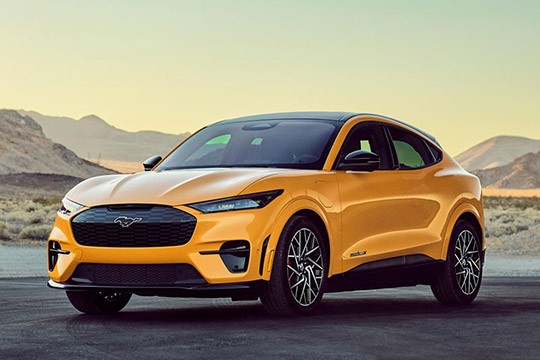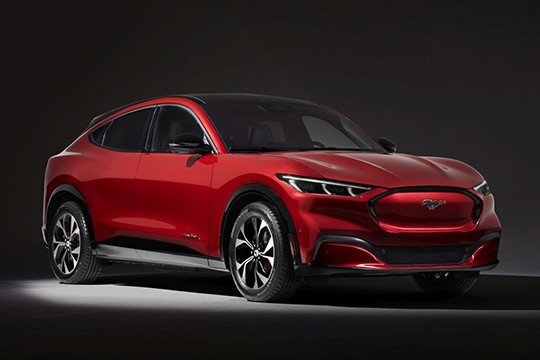FORD Mustang MACH-E Models/Series Timeline, Specifications & Photos
First production year: 2020
Engines: Electric
Body style: SUV (Sports Utility Vehicle)
The Mustang Mach-E GT was not the kind of Mustang John Oros imagined in the mid-60s, but it was surely quicker than any muscle car from that era, even with five people on board.
Back in 1964, JFK was in the office, and Mustang started the pony-car culture. Fast forward almost six decades, and there were still unanswered questions about JFK, but we knew that the battery-powered crossover was far away from what Ford imagined about a sports car when it introduced the 1964 ½ Mustang.
Unlike the standard Mach-E, the GT sported a unique orange color and a few fine details that made it look different than its less-powered sibling. Its wide hexagonal black grille featured the iconic wild horse illuminated. The front bumper was different, while the apron featured the active grille shutters. A more aggressive splitter caught the air and diverted it to the sides through a pair of vents, creating an air curtain around the vehicle. The piano-black lower side sills made the profile look slimmer and lower to the ground from its sides. In the back, it was very similar to the regular Mustang Mach-E.
Inside, Ford designers didn't bother to enhance the look too much. Sure, there were some GT stitchings around the cabin on the seats, steering wheel, center armrest, and the door sills. But the bolstered seats were almost the same, and there were no unique carbon-fiber trims as expected in such a performance vehicle.
Under the skin, Ford installed two electric motors that provided 480 hp for both GT versions. The regular model offered 600 lb-ft (814 Nm) of torque, while the Performance version added 34 more lb-ft (46 Nm).
This was the most revolutionary model that wore the Mustang nameplate, and many of the brand's fans were outraged because of it. But still, the vehicle was appreciated for its attributes.
In 1964, Ford introduced the Mustang as the original pony car and built it for six generations before creating the most unusual version of it, the Mustang Mach-E. While only the nameplate and several design cues were carried over from the famous American coupe, the rest of the vehicle was completely new from the ground up. Unlike its stablemate, it was an SUV coupe with an all-electric drivetrain fit for the next generation of customers who didn't think of a vehicle as a gasoline-powered one but as an electron-powered car that could do more than just run fast on highways and streets. It was also perfectly capable of driving on unpaved roads or in slippery conditions. On top of that, the high technology level of the Mach-E made it a best-buy for many young customers who didn't like gasoline-powered vehicles as much as their parents did.
The 2020 Mustang Mach-E designers took inspiration from the Mustang coupe when they designed the vehicle and created similar-looking headlights for the electric SUV. As a result, the narrow, swept-back LED headlamps featured three vertical daytime lines connected to the upper, eyebrow-like one, like in the 2020 Mustang. Between them, since the car didn't need a broad cooling area, the automaker placed a panel shaped like the Mustang's grille and an air intake lower in the apron. From its profile, the coupe-shaped greenhouse featured a sloped-down roof line and narrow windows. The rear fenders sported oversized shoulders that created a muscular aspect for the car. Finally, at the back, the raked-forward tailgate was adorned by a wide roof spoiler, while the taillights featured the same three vertical lines pattern as in the Mustang family.
Inside, the high-tech environment was dominated by the big, portrait-mode touchscreen for the infotainment system, while the driver fronted another display used as an instrument panel. The front occupants were separated by the tall center console that housed a pair of cup holders, an armrest, the transmission controller, and the parking brake switch. Their high-bolstered bucket seats were available with electric adjustments, heating, and ventilation. In the back, there was room enough for three occupants with enough headroom despite the sloped-down roof. A panoramic glass roof was offered as an option.
Under the skin, Ford installed a choice of three powertrain options with rear or all-wheel drive one or two motors. These were fed by a 98,8 kWh battery pack that ensured the car had a long enough range to fit customers' needs for daily transportation. In addition, thanks to the high instant torque provided by the electric motors, the vehicle was able to sprint quickly enough to match its coupe sibling.

